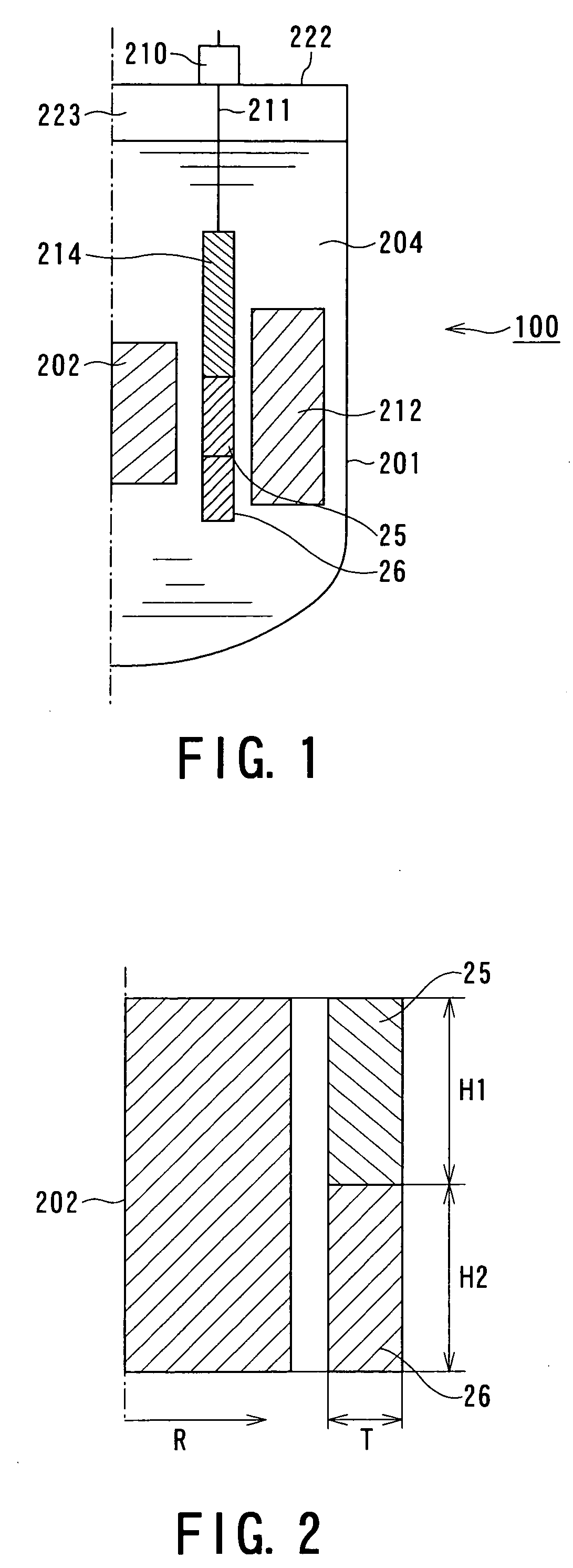Fast reactor having reflector control system and neutron reflector thereof
a control system and reactor technology, applied in nuclear engineering problems, nuclear elements, greenhouse gas reduction, etc., can solve the problems of excessive increase in reactivity around the middle burn-up stage, gradual decrease of reactivity and becoming considerably low, and increase in reactivity tend to be saturated, so as to reduce reactivity and increase reactivity. , the effect of decreasing reactivity
- Summary
- Abstract
- Description
- Claims
- Application Information
AI Technical Summary
Benefits of technology
Problems solved by technology
Method used
Image
Examples
first embodiment
[0097]FIG. 1 is a vertical cross-sectional view of a fast reactor 100 of a first embodiment according to the present invention. In this embodiment, the same reference numerals of the constituent elements of the fast reactor 200 shown in FIG. 33 designate constituent elements substantially equivalent thereto, and descriptions thereof will be omitted.
[0098] The fast reactor 100 is different from the related fast reactor 200 in terms of the structure of the neutron reflector 209. That is, although the neutron reflector 209 of the fast reactor 200 is a one-piece product which is not divided and which is formed of the same material in the axial direction, the neutron reflector of the fast reactor 100 is formed of an upper reflector 25 and a lower reflector 26.
[0099]FIG. 2 is an enlarged vertical cross-sectional view showing the positional relationship among the reactor core 202, the upper reflector 25, and the lower reflector 26 of the fast reactor 100.
[0100] As shown in FIG. 2, for e...
second embodiment
[0108]FIG. 6 is a vertical cross-sectional view of a fast reactor having a reflector control system of a second embodiment according to the present invention, and in particular, is an enlarged view showing the reactor core 202 and reflectors 25, 26, and 27. In this figure, constituent elements corresponding to those shown in FIG. 1, which is a vertical cross-sectional view of the fast reactor of the first embodiment, are omitted. However, the elements are identical to those shown in FIG. 1 except for the reflector portion shown in FIG. 6. Heights H3, H4, and H5 of the upper reflector 25, the center reflector 27, and the lower reflector 26, respectively, are such that H3 is 70 cm, H4 is 60 cm, and H5 is 70 cm.
[0109] In addition, the upper reflector 25 is made of austentic stainless steel, the center reflector 27 is made of ferritic stainless steel, and the lower reflector 26 is made of graphite. As for the degree of reactivity, as shown in FIG. 43, graphite is high, ferritic stainle...
third embodiment
[0111]FIGS. 8A, 8B, and 8C are vertical cross-sectional views each showing a reflector of a fast reactor having a reflector control system of a third embodiment according to the present invention. The reflector is formed of a single composition of ferritic stainless steel. However, in the lower region of the reflector, in FIG. 8A, the thickness thereof is gradually increased toward the bottom side, and the reflector in FIG. 8B has a large and uniform thickness. As shown in FIG. 46, since the reflection ability is increased as the thickness is increased, the similar effect as that of the first embodiment can be obtained. The reflector shown in FIG. 8C has a larger thickness at the upper portion than that at the central portion, and the lower portion has the largest thickness; hence, the similar effect as that of the second embodiment can be obtained.
[0112] The dimensions of the individual reflectors are described below. In the example shown in FIG. 8A, an upper thickness T1 is set t...
PUM
 Login to View More
Login to View More Abstract
Description
Claims
Application Information
 Login to View More
Login to View More - R&D
- Intellectual Property
- Life Sciences
- Materials
- Tech Scout
- Unparalleled Data Quality
- Higher Quality Content
- 60% Fewer Hallucinations
Browse by: Latest US Patents, China's latest patents, Technical Efficacy Thesaurus, Application Domain, Technology Topic, Popular Technical Reports.
© 2025 PatSnap. All rights reserved.Legal|Privacy policy|Modern Slavery Act Transparency Statement|Sitemap|About US| Contact US: help@patsnap.com



